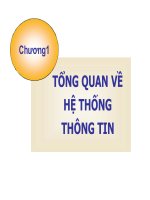Bài giảng Kinh doanh điện tử - Chương 1: Tổng quan về kinh doanh điện tử
Bạn đang xem bản rút gọn của tài liệu. Xem và tải ngay bản đầy đủ của tài liệu tại đây (1.4 MB, 44 trang )
Kinh doanh điện tử
Chương 1 -Tổng quan về Kinh
doanh điện tử
Nội dung
• Khái niệm về kinh doanh điện tử và hệ
kinh doanh điện tử
• Các mô hình kinh doanh điện tử
•
Kiến
trúc
hệ
kinh
doanh
điện
tử
•
Kiến
trúc
hệ
kinh
doanh
điện
tử
• Cơ sở hạ tầng cho hệ kinh doanh điện tử
-2-
Một số khái niệm
• Kinh doanh điện tử (Electronic Business)
• Thương mại điện tử (Electronic
Commerce)
•
Thương
mại
di
động
(Mobile Commerce)
•
Thương
mại
di
động
(Mobile Commerce)
• Hệ kinh doanh điện tử (E-Business
System)
-3-
E-commerce
• “E-commerce is the exchange of
information across electronic networks, at
any stage in the supply chain, whether
within an organization, between
within an organization, between
businesses, between businesses and
consumers, or between the public and
private sector, whether paid or unpaid.”
(Cabinet Office, 1999)
-4-
E-commerce
• All electronically mediated information
exchange between an organization and its
external stakeholders (Chaffey)
•
Digitally enabled commercial transactions
•
Digitally enabled commercial transactions
between and among organizations and
individuals (Laudon)
-5-
E-Commerce
• Kalakota và Whinston (1997), đã đưa ra
một số quan điểm khác nhau về thương
mại điện tử:
–
A communications perspective
–
A communications perspective
– A business process perspective
– A service perspective
– A online perspective
-6-
E-business
• “e-business (e’biz’nis) – the transformation
of key business processes through the use
of Internet technologies.”(IBM, 1997)
-7-
E-business
• “when a business has fully integrated
information and communications
technologies (ICTs) into its operations,
potentially redesigning its business
processes around ICT or completely
processes around ICT or completely
reinventing its business model . . . e-
business, is understood to be the
integration of all these activities with the
internal processes of a business through
ICT.” (DTI, 2000)
-8-
E-business
• All electronically mediated information exchanges,
both within an organization and with external
stakeholders supporting the range of business
process (Chaffey)
•
Digital enablement of transactions and processes
•
Digital enablement of transactions and processes
within a firm, involving information systems under
firm’s control. Does not include commercial
transactions involving an exchange of value across
organizational boundaries (Laudon)
-9-
-12-
Hệ kinh doanh điện tử
(E-Business System)
• Là một dạng của hệ thống thông tin
• Các hệ thống thông tin hỗ trợ kinh doanh
điện tử (information systems for e-
business)
business)
Hệ thống thông tin
-14-
J. O’Brien, G. M. Marakas. Introduction to Information Systems, Chapter 1: Foundations of Information Systems in
Business. McGraw-Hill, 2010.
Kiến trúc hệ kinh doanh điện tử
-15-
Kiến trúc hệ kinh doanh điện tử
-16-
4 kiểu site TMĐT bên bán
• Transactional e-commerce
• Services-oriented relationship-building
• Brand-building
•
Portal, publisher or media
•
Portal, publisher or media
-17-
Activity 1: What type? (p.16)
• Guinness
(www.guinness.com)
•
Consumer site Yahoo!
• Transactional e-
commerce
• Service-orientated
relationship-building
•
Brand
-
building
•
Consumer site Yahoo!
(www.yahoo.com)
• Online retailer: Amazon
(www.amazon.com)
• Pricewaterhouse Cooper
(www.pwcglobal.com)
•
Brand
-
building
• Portal or media
• Social network or
community site
Intranet và Extranet
-21-
Mô hình kinh doanh (Business
Model)
• “An architecture for product, service and
information flows, including a description
of the various business actors and their
roles; and a description of the potential
roles; and a description of the potential
benefits for the various business actors;
and a description of the sources of
revenue.” (Timmers, 1999)
-22-
Các mô hình kinh doanh
• Theo Timmers (1999):
– E-shop
– E-procurement
– E-malls
–
E
-
auctions
–
E
-
auctions
– Virtual communities
– Collaboration platforms
– Third-party marketplaces
– Value-chain integrators
– Value-chain service providers
– Information brokerage
– Trust and other services
-23-
Quan điểm khác về mô hình kinh doanh
-24-
Web 2.0 and Beyond
• Web 2.0
– Features-p. 24
– Web 2 examples
•
Web 3.0 Features
-
pp. 24
-
25 Box 1.1
•
Web 3.0 Features
-
pp. 24
-
25 Box 1.1
– Research the web to discover what Web 3.0
technology and features have been used by
which company
-25-
Figure 1.7 Evolution of web technologies
Source: Adapted from Spivack (2007)
Khả năng kinh doanh điện tử của một tổ chức
-29-









